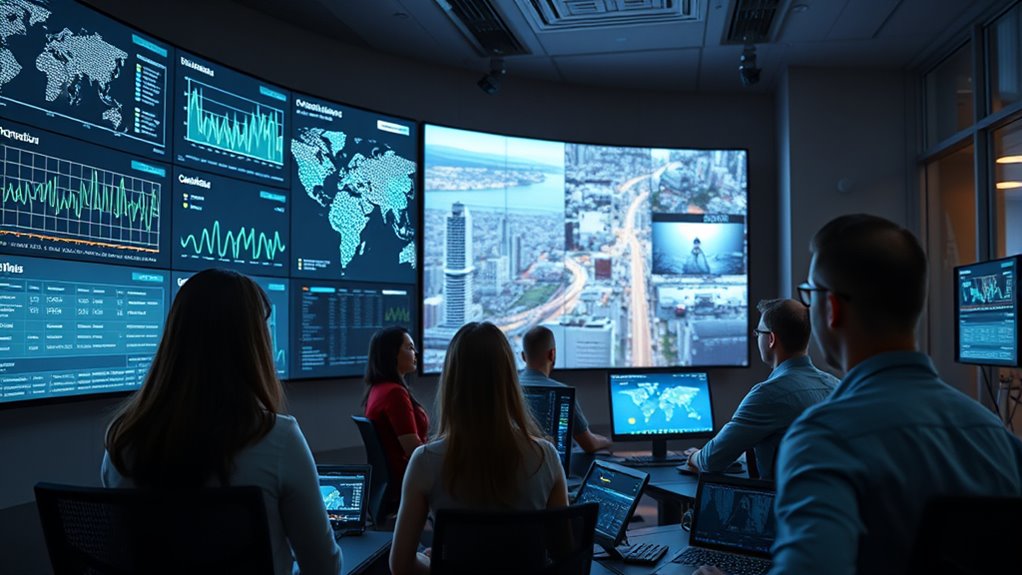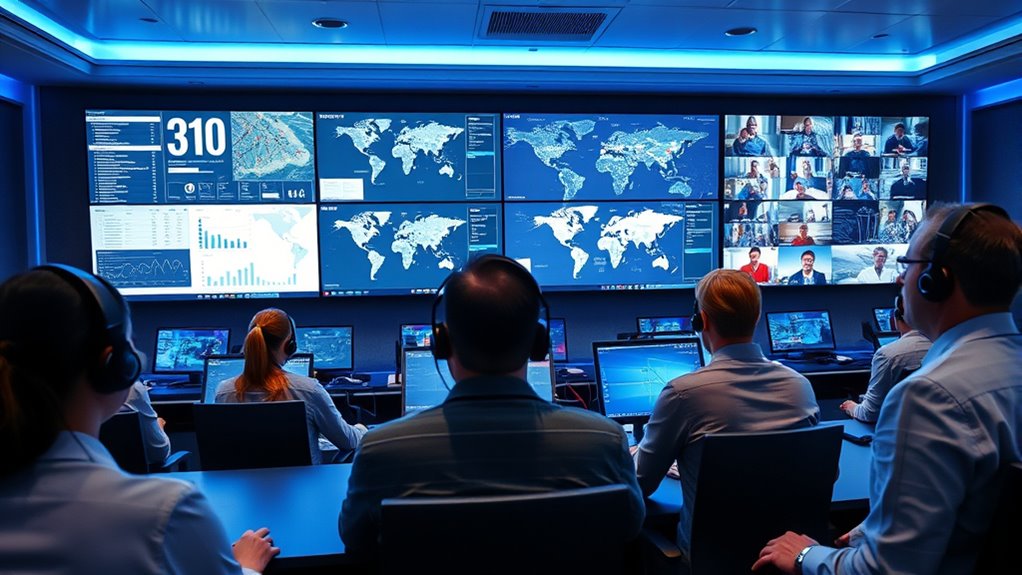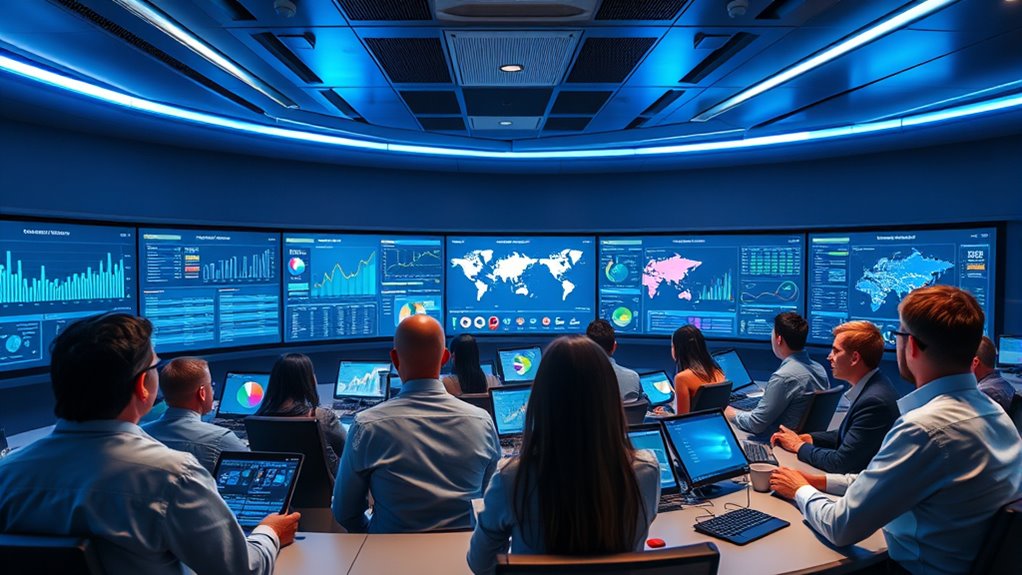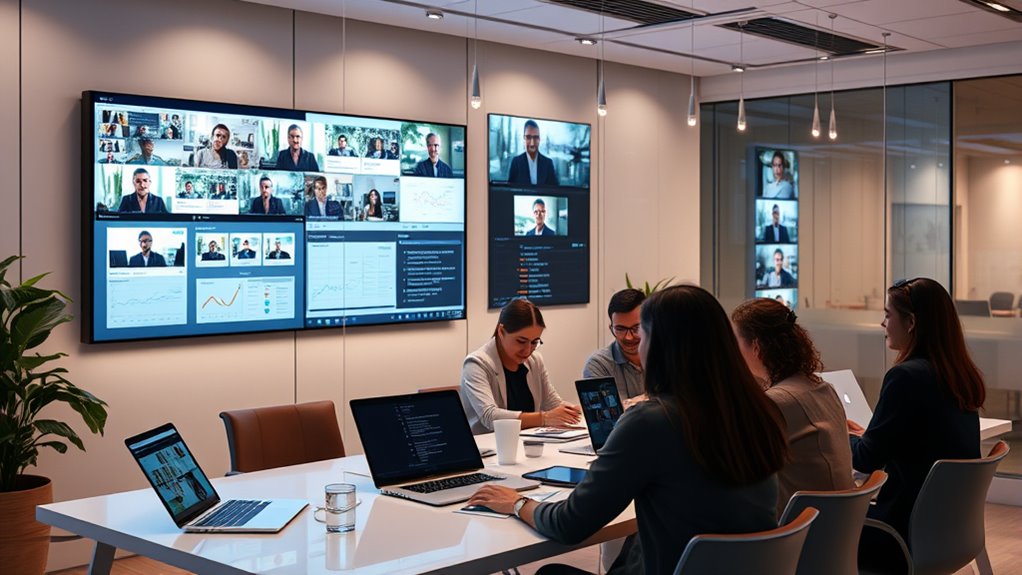To manage multi-location remote operations effectively, focus on establishing clear communication channels like video calls and instant messaging, using reliable tech tools, and promoting transparency to build trust. Set consistent standards, monitor performance with data analytics, and encourage collaboration through informal virtual events. Managing different time zones requires flexible scheduling and shared calendars to maximize overlap. Staying compliant and fostering a unified team environment are essential. Continue exploring strategies to optimize your remote management approach.
Key Takeaways
- Implement consistent communication channels and foster open dialogue to ensure team alignment across all locations.
- Utilize scalable technology solutions, including secure remote access and shared digital tools, for seamless collaboration.
- Establish clear standards, procedures, and regular audits to maintain compliance and operational consistency.
- Leverage real-time data and dashboards for performance monitoring and informed decision-making.
- Promote team engagement through virtual social activities, regular check-ins, and recognition to build a cohesive remote culture.
Establishing Clear Communication Channels

Effective communication is essential when managing multiple locations remotely, as it guarantees everyone stays aligned and informed. You need to set up clear channels for sharing information, whether through regular video calls, instant messaging apps, or email updates. Make sure each team knows where to find important documents and updates, and establish a routine for check-ins. Encourage transparency and open dialogue so issues are addressed promptly. Use consistent terminology and protocols to avoid misunderstandings. Clearly define who is responsible for what, and ensure everyone understands their roles and expectations. By establishing reliable communication channels, you create a foundation of trust and efficiency. This clarity helps prevent miscommunication, keeps teams engaged, and ensures everyone moves toward shared goals seamlessly. Incorporating effective communication strategies can significantly improve coordination across multiple locations.
Implementing Robust Technology Solutions

To effectively manage multiple locations remotely, you need a reliable network infrastructure that keeps everyone connected. Secure remote access guarantees your team can work safely from anywhere, without risking data breaches. Additionally, scalable system integration allows your technology to grow with your operations, preventing future bottlenecks. Incorporating seasonal considerations into your planning can also improve operational efficiency and resilience.
Reliable Network Infrastructure
A reliable network infrastructure forms the backbone of successful remote management across multiple locations. It ensures seamless communication, quick data transfer, and minimal downtime. To achieve this, you need to invest in high-quality hardware, redundant connections, and scalable bandwidth. Prioritize consistent monitoring to detect issues early and maintain peak performance. Consider the following key components:
| Component | Purpose | Benefits |
|---|---|---|
| Redundant Links | Prevent network outages | Increased uptime |
| Quality Routers | Efficient data routing | Faster data transfer |
| Bandwidth Management | Optimize network usage | Avoid congestion |
| Network Monitoring | Detect and resolve issues early | Reduced downtime |
| Hardware Scalability | Support growth and expansion | Future-proof infrastructure |
Implementing robust network solutions can significantly enhance the resilience and efficiency of your multi-location operations.
Secure Remote Access
Building a solid network infrastructure is only part of the equation; ensuring secure remote access is essential for protecting your operations across multiple locations. You need to implement strong authentication methods, like multi-factor authentication, to verify users’ identities. Using Virtual Private Networks (VPNs) encrypts data, preventing unauthorized interception. It’s *vital* to keep remote access software and systems up to date, patching vulnerabilities promptly. Role-based access controls limit what users can see and do, reducing potential damage if credentials are compromised. Regularly monitor access logs for suspicious activity. Educate your team on security best practices, like avoiding public Wi-Fi and recognizing phishing attempts. Additionally, understanding Home Improvement strategies can help optimize your workspace ergonomics and comfort. By applying these strategies, you create a resilient remote access system that safeguards your multi-location operations from cyber threats.
Scalable System Integration
Implementing robust technology solutions is essential for guaranteeing your multi-location operations can grow and adapt seamlessly. Scalable system integration allows you to connect diverse tools and platforms, creating a unified environment. To achieve this, focus on:
- Standardizing protocols to ensure compatibility across systems.
- Utilizing APIs for smooth data exchange between platforms.
- Choosing modular solutions that can expand with your needs.
- Prioritizing cloud-based systems for flexibility and remote access.
- Incorporate farmhouse-inspired design elements to foster a welcoming and cohesive environment across locations.
These steps help prevent silos, streamline workflows, and enhance overall efficiency. When your systems are integrated effectively, your team can make faster decisions, respond to changes quickly, and maintain consistency across locations. Scalability becomes a strategic advantage, not a challenge.
Setting Consistent Standards and Procedures

To guarantee smooth and uniform operations across multiple locations, establishing clear standards and procedures is essential. You need to define consistent workflows, policies, and expectations that everyone follows. Document these standards thoroughly and make them easily accessible to all teams. Train staff regularly to ensure they understand and adhere to these procedures, fostering accountability. Use standardized templates and checklists to streamline tasks and reduce errors. Clear communication is crucial—everyone should know their roles and responsibilities. When standards are consistent, you improve efficiency, quality, and compliance across locations. Regularly review and update procedures to adapt to changing needs or challenges. Incorporating essential oils into wellness protocols can also support staff well-being and productivity. This approach creates a unified operational framework, enabling better coordination and a cohesive brand experience.
Monitoring Performance With Data Analytics

Once standards and procedures are in place, tracking how well they’re followed becomes essential. Data analytics lets you monitor performance effectively across locations. It provides insights that help identify areas for improvement and validate success. To make the most of it, focus on:
Effective performance tracking with data analytics drives continuous improvement and validates success across all locations.
- Collecting real-time data to respond quickly to issues
- Analyzing trends over time for strategic planning
- Using dashboards for visual insights that are easy to interpret
- Setting benchmarks to measure progress accurately
- Incorporating asset division considerations to ensure resource allocation aligns with legal and financial priorities
Fostering a Collaborative Remote Culture

To build a strong remote culture, you need to prioritize open communication and make certain everyone feels heard. Encouraging team engagement helps break down silos and fosters trust across locations. When you actively promote these practices, collaboration becomes seamless and more effective. Incorporating wall organization strategies can further enhance clarity and shared understanding among team members.
Emphasize Open Communication
Open communication forms the foundation of a collaborative remote culture, enabling team members across multiple locations to stay connected and aligned. To foster this, prioritize transparency and accessibility. Make sure everyone feels comfortable sharing ideas and concerns by:
- Using clear, consistent messaging channels
- Encouraging regular updates and check-ins
- Creating a safe environment for feedback
- Actively listening to team members’ perspectives
Additionally, integrating tools that promote effective communication can significantly enhance team cohesion and understanding.
Promote Team Engagement
Fostering team engagement is essential for building a strong, collaborative remote culture. You can achieve this by encouraging participation in team discussions and recognizing individual contributions. Use regular check-ins to create opportunities for team members to share updates and ideas, making everyone feel valued. Incorporate interactive tools like polls or virtual brainstorming sessions to boost involvement. To deepen connections, organize informal virtual events or social chats that build camaraderie beyond work tasks. When team members feel engaged, they’re more motivated, productive, and committed to shared goals. As a manager, your role is to facilitate an environment where input is welcomed, and achievements are celebrated—this cultivates trust and a sense of belonging across all locations. Additionally, staying informed about crypto opportunities can inspire innovative ways to motivate your remote team through shared learning experiences.
Managing Time Zones and Scheduling Efficiently

Managing time zones and scheduling efficiently can be challenging when coordinating across multiple locations. To streamline this process, consider these key strategies:
Coordinating across multiple locations? Use shared calendars and flexible hours to simplify scheduling.
- Use shared digital calendars to identify overlapping work hours.
- Schedule meetings during times that suit the majority, avoiding extremes.
- Implement flexible working hours to accommodate different time zones.
- Communicate clearly about deadlines and expectations, accounting for local times.
Addressing Challenges and Ensuring Compliance

While coordinating schedules across multiple locations helps improve efficiency, it also introduces specific challenges that can hinder smooth operations. Ensuring compliance with local regulations, maintaining consistent quality, and managing communication gaps are critical issues. To visualize this, consider the following:
| Challenge | Solution | Impact |
|---|---|---|
| Regulatory compliance | Regular audits and updates | Avoid penalties, build trust |
| Quality consistency | Standardized procedures | Customer satisfaction |
| Communication barriers | Clear protocols and tools | Faster problem resolution |
Addressing these challenges requires proactive planning. You must stay informed about regional laws, standardize processes, and facilitate open communication channels. Doing so helps you maintain compliance, uphold quality, and keep operations seamless across all locations.
Frequently Asked Questions
How Can Remote Managers Build Trust Across Multiple Locations?
Building trust across multiple locations starts with clear communication and transparency. You should regularly check in, listen actively, and share updates honestly to foster openness. Show appreciation for your team’s efforts, set consistent expectations, and follow through on promises. By demonstrating reliability and being approachable, you create a sense of unity and confidence, making your team feel valued and trusted, regardless of where they work.
What Strategies Ensure Consistent Customer Experience Across All Sites?
Oh, sure, just sprinkle some fairy dust and guarantee a perfect customer experience everywhere—easy, right? But seriously, you should standardize procedures, train staff thoroughly, and use consistent branding and messaging. Regular audits and feedback loops help catch inconsistencies before customers notice. By empowering local managers and leveraging technology, you create a seamless, uniform experience that keeps customers happy no matter which location they visit.
How Do Remote Teams Handle Conflicting Priorities Effectively?
You handle conflicting priorities by clearly communicating goals and setting transparent expectations. Prioritize tasks based on urgency and overall impact, often using tools like dashboards or project management software. Regular check-ins help you stay aligned with team members, address issues early, and adapt plans as needed. Staying flexible and fostering open dialogue ensures everyone understands the bigger picture, enabling you to navigate conflicts efficiently and keep operations running smoothly.
What Are Best Practices for Remote Conflict Resolution?
Addressing conflicts is like steering stormy seas—you need a steady hand. To do this, stay calm and listen actively to understand each person’s perspective. Encourage open communication and focus on common goals. Set clear expectations for resolution processes, and be fair and consistent. Remember, resolving conflicts quickly and effectively keeps your team sailing smoothly, even through choppy waters. Your proactive approach creates a harmonious work environment, boosting productivity.
How Can Remote Management Adapt to Changing Regulations?
You need to stay flexible and proactive as regulations change. Regularly review updates from authorities and adapt your policies accordingly. Use technology to monitor compliance across locations, and communicate these changes clearly to your team. Training sessions help ensure everyone understands new rules. By staying informed and responsive, you can smoothly navigate regulatory shifts and keep your operations compliant and efficient.
Conclusion
By mastering these strategies, you’re well on your way to seamless remote management across multiple locations. But remember, every environment presents unique challenges that could disrupt your progress. Will your current systems withstand unforeseen obstacles? Stay vigilant, adapt swiftly, and continually refine your approach. The future of your multi-location operations depends on your ability to anticipate and respond — the next move could be the game-changer you’ve been waiting for.









